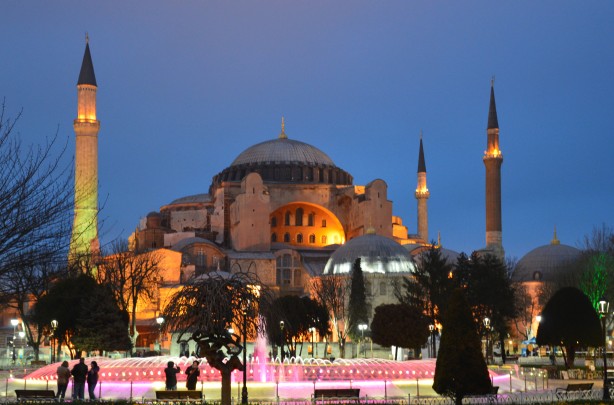Analyzing Early Christian, Byzantine, and Early Medieval Architecture
Help Questions
AP Art History › Analyzing Early Christian, Byzantine, and Early Medieval Architecture

This building does NOT have a(n) .
atrium
apse
nave
narthex
Explanation
The church is a combination of central and Basilica plan. It has all of the standard additions of those styles, including the nave and apse, as almost every church of this type does. The narthex is identified as the porch-like addition opposite the apse. This church does not have an atrium, however, which would look like a long open plan that sits before the church door.
Image adapted from http://www.publicdomainpictures.net/hledej.php?hleda=hagia+sophia+5.

Construction of the building in its current form began in .
the sixth century BCE
the eighth century BCE
the ninth century BCE
the fourth century BCE
Explanation
The current layout of the Hagia Sophia was begun by Justinian II in 532. It was ordered after his predecessors tried and failed to build a monumental building in that area. As Justinian was largely regarded as the first Byzantine emperor, the Hagia Sophia became a seminal work for Byzantine and later Eastern Orthodoxy churches.
Image adapted from http://www.publicdomainpictures.net/hledej.php?hleda=hagia+sophia+5.

The structure reveals the influence of all but which of the following?
Medieval English Church style
Roman secular structures
The Turkish Islamic architectural tradition
Early Byzantine artistry
Explanation
The Hagia Sophia has been a Greek Orthodoxy church, a Roman Catholic Cathedral, a Mosque, and a museum. In fifteen hundred years of history, the building has seen influence from all over Europe. The minarets are Islamic, the mosaics on the interior are Byzantine, and the plan is Basilica, based on the Roman civic structures. What is has not ever seen the influence of, however, is the Church of England, which came about after the Hagia Sophia had already become a mosque.
Image adapted from http://www.publicdomainpictures.net/hledej.php?hleda=hagia+sophia+5.

Why would the Islamic Turks cover the mosaics on the interior of this structure with plaster?
The Islamic tradition forbids the artistic depiction of figures.
Islamic Turkish places of worship traditionally featured plain, undecorated interiors.
The Turks did not appreciate mosaic art.
The building was sacked, and the mosaics were taken apart and shipped to interested foreign parties.
Explanation
Islamic tradition bans the depiction of figures as inspiring idolatry; works depicting figures would be considered sacrilegious. When the church became a mosque, the mosaics were plastered over so that there were no faces in the new mosque, and there would only be Arabic script as decoration.
Image adapted from http://www.publicdomainpictures.net/hledej.php?hleda=hagia+sophia+5.

The interior of the building is likely decorated with .
mosaics depicting biblical figures
rich oil paintings of Christian martyrs
encaustic designs
precious metals
Explanation
The Hagia Sophia was built just after the birth of the Roman Christian tradition, and came well before the advent of Renaissance oil paintings in churches. It was also built in the Middle East, and was influenced by the artistic traditions of the area. It therefore likely has mosaics on the inside, which are the cornerstone of Byzantine church art.
Image adapted from http://www.publicdomainpictures.net/hledej.php?hleda=hagia+sophia+5.

The tall, thin towers are called .
minarets
muezzins
cornices
muqarnas
Explanation
The towers are called minarets. They are an Islamic addition to the church, added when it became a mosque in the fifteenth century after the Turks sacked Constantinople. These towers are not universal, but are common in Islamic mosque architecture.
Image adapted from http://www.publicdomainpictures.net/hledej.php?hleda=hagia+sophia+5.

The architect of the building was .
Isidore of Miletus
Procopius
Eusebius of Nicomedia
Justinian II
Explanation
Isidore of Miletus, along with his companion the mathematician Anthemius of Tralles, was commissioned by Justinian I to create the Hagia Sophia. Anthemius died shortly before construction could begin, so Isidore continued alone. He was considered the father of the current structure, minus the Islamic artistic additions.
Image adapted from http://www.publicdomainpictures.net/hledej.php?hleda=hagia+sophia+5.

The plan of this building is .
central and Basilica
Romanesque
Classic
longitudinal
Explanation
The Hagia Sophia has all the standard additions of the Basilica-plan church, including the apse opposite the door, a nave in the center, and aisles on each side. It lacks the cross-like arms of later Basilica churches. It also has a domed top and a square-ish base, which are both central-plan additions. It is unique in this way among its contemporaries.
Image adapted from http://www.publicdomainpictures.net/hledej.php?hleda=hagia+sophia+5.

The building was originally a .
church
mosque
temple
civic building
Explanation
The Hagia Sophia was originally built as an early Greek Orthodox church. It is difficult to consider the architecture as of a particular time period or style as it has been changed and influenced so many times. There are, however clear remnants of Greek Classical style as well as the early hints of what will become the Romanesque church style.
Image adapted from http://www.publicdomainpictures.net/hledej.php?hleda=hagia+sophia+5.

In the long history of the building, what has consistently been a concern of architects?
All of the other answers are correct.
The outward shift of the buttressing
The weight of the dome
The ratio of brick to mortar
Explanation
All of these are problems that have concerned and maddened builders since the construction of the building began, and all the problems are related to one other. The dome is very heavy, and when it's sitting on the foundation, it pushes the buttressing outward. The dome is so heavy in part because the brick to mortar ratio is 1:1, making the dense and heavy mortar far more weighty than it should be.
Image adapted from http://www.publicdomainpictures.net/hledej.php?hleda=hagia+sophia+5.